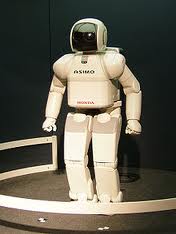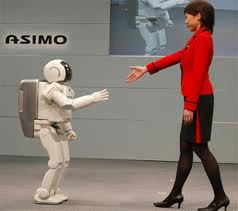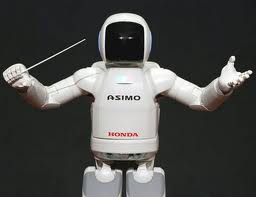一提到机器人,你的第一印象是什么?一个个冷冰冰的钢铁躯壳?总是毫无怨言地做着枯燥无味的工作?这是工业机器人的惯有形象。而Rico马上想到的是两年前出现在大荧幕上的机器人瓦力——虽然它没有人类的形态,说白了也就是四方铁盒子加探视镜和运输带还有铁钳子拼凑而成的小东西,但是它那双可爱的大眼睛却萌得无懈可击。如今,现实生活中也出现了一个憨态可掬的机器人明星——它就是人形机器人阿西莫(ASIMO)。如果你曾经在电视上或某些展会上一睹阿西莫的风采,相信你也会想要一个属于自己的阿西莫吧。随着科技的发展,未来机器人无论是在外形上还是性能上都必将更胜一筹。也许某天,它们也能像瓦力那样,寻找一段属于自己的爱情哦。
 What if we could wear bodysuits to give us super strength? Own an identical robot twin to work for us? What if we could travel through time? Technology is pushing from every direction, getting faster with each passing second. Prepare yourself! The future is closer than ya think.
What if we could wear bodysuits to give us super strength? Own an identical robot twin to work for us? What if we could travel through time? Technology is pushing from every direction, getting faster with each passing second. Prepare yourself! The future is closer than ya think.
A robot conducting[指挥] a symphony orchestra[交响乐团] – amazing as that is, it’s just one way reality is outpacing[(在速度上)超过] science fiction. Every day, robots become even more sophisticated[复杂的], taking on additional human traits. Until now, robots have mostly gotten the toughest jobs. They work the assembly line[装配线] and defuse[拆除(炸弹)的引信], or even detonate[引爆] explosive devices.
James Kuffner (Robot Expert): The traditional tasks for a robot [have] always been the 3Ds – dull, dirty, dangerous. But as the technology improves and as the researchers are working towards developing these intelligent humanoids[人形机器人], we’re going to see our homes and offices occupied by robots. I believe that humanoid technologies will improve our lives in the 21st century.
The world capital of human-like robots is Japan.
Kuffner: Half of the industrial robots in the world are in Japan. Japan sees itself as a leader in
robot and humanoid technology. The country even has a new kind of celebrity – a humanoid robot named ASIMO.
ASIMO is probably the world’s most famous humanoid right now.
ASIMO: My creators have been at this for over 20 years. At first, we look[ed] like TV sets with legs; later, we looked more like humans.
Kuffner: It makes sense that if you’re going to build a general-purpose[一般用途的] robot that can perform any task that a human can do, you’d like to make it anthropomorphic[神、人同形同性论的] and have a human shape.
ASIMO walks gracefully. His creators studied motion capture video of both humans and animals. Designed to detect the ground beneath him, his body responds appropriately, so ASIMO keeps his balance.
His appearance was also a careful choice.
ASIMO: I am just under four feet tall, the size of an eight-year-old boy.
Kuffner: So he’s a small-stature[身材] humanoid and in that way he’s very non-threatening and people have an affinity[吸引力] for ASIMO.
Especially considering all that ASIMO can do for us.
Kuffner: They’ll be able to assist us much in the same ways our computers have, but now suddenly this
powerful computer is mobile and can actually act upon your commands. They’ll be connected to the Internet so that if you need some information you don’t have to go to a terminal[终端设备] and type a search term, you can just ask your robot.
In the future we’ll tell our robots to clean the house, make dinner, even pick up the kids at school. They’ll monitor[监控] our family’s health and home security.
 Female Robot: Welcome home, Brain. Catherine has left the house.
Female Robot: Welcome home, Brain. Catherine has left the house.
And if necessary, call 911. They’ll be our live-in nurses, monitoring our vital[生命攸关的] signs. Eventually they’ll even replace the doctor.
Kuffner: And as we move towards these intelligent sort of autonomous[自治的] domestic robots in the future, the robots will be able to learn new skills by observing other humans do them or by learning from other robots.
The day when we all have our personal ASIMO is not far off.
ASIMO: Someday in the near future I will be sold to you guys. I’m really looking forward to that.
It’s projected that more than four million homes will soon have personal robots. The South Korean
government hopes to put robots in every home no later than 2020.
Kuffner: If you learn from history, I believe that in the next 20 years the price will be cheap enough that we’ll be able to afford household robots, and I believe again it will transform our society.
It’s predicted that robots with human-level
intelligence could arrive as early as the year 2029. A society of smart undetectable[无法察觉的] androids[人形机器人] in our midst[中间] may seem alarming, but for now we’ll still be the ones in charge.
Kuffner: We can always turn off the power.
如果我们穿上一套连体紧身衣就能获得超凡力量,那会是怎样的情形?拥有一个和自己一模一样的机器人为你工作又如何?要是我们能穿梭时间呢?科技从四面八方挤压而来,每一秒都发展得更快。做好准备吧!未来比你想象的近得多。
机器人指挥交响乐团——这听起来很神奇,实际上它只是现实赶超科幻小说的一个侧面而已。机器人一天比一天复杂,拥有更多额外的人类特征。到目前为止,机器人主要从事最艰苦的工作。他们在流水线上工作,拆除炸弹的引信,甚至引爆爆炸装置。
詹姆斯·卡夫纳(机器人专家):长期以来,机器人的传统任务均为枯燥、肮脏、危险的工作。然而,随着科技发展,研究人员致力于开发智能人形机器人,我们将会看到越来越多的机器人出现在我们的家庭和办公室。我相信,人形机器人技术将在21世纪改善我们的生活。
人形机器人的世界之都是日本。  卡夫纳:全球有一半的工业机器人在日本。日本视自己为机器人及人形机器人科技的领跑者。该国甚至已经出现一种新明星——一个叫阿西莫的人形机器人。
卡夫纳:全球有一半的工业机器人在日本。日本视自己为机器人及人形机器人科技的领跑者。该国甚至已经出现一种新明星——一个叫阿西莫的人形机器人。
阿西莫可能是目前世界上最出名的人形机器人。
阿西莫:我的创造者研究人形机器人已有二十余载。起初,我们看起来就像一台长着两条腿的电视机;后来,我们看起来更像人类了。
卡夫纳:这很容易理解——如果你想制造一个一般用途的机器人,让它完成任何一项人类可以完成的任务,你就会将它做成人形,让它拥有人类的形态。
阿西莫步姿优雅。通过研究人类和动物的动态捕捉视频,研发人员对其行走方式进行精心设计。阿西莫能探测脚下的地面情况,躯干随之作出适当反应,从而保持身体平衡。
阿西莫的外观设计也经过了一番考究。
阿西莫:我的身高不足四英尺(1.2米),体型犹如一个八岁小男孩。
卡夫纳:因此它是一个身材娇小的人形机器人,毫无威胁感,人们更容易与
阿西莫亲近。
尤其是考虑到阿西莫能为我们做的事情(人们会更喜爱它)。
卡夫纳:它们将能像电脑那样协助我们,但是突然之间,这台强大的电脑能四处走动,并且遵照你的指令行事。它们能连接到因特网,因此当需要某些资料的时候,你不必跑到电脑终端前输入搜索项,只需询问你的机器人就可以了。
在未来,我们将可以直接使唤机器人打扫卫生,烹煮三餐,甚至接孩子放学。它们也将能监控我们家人的健康和家庭安全。
女机器人:欢迎回家,布莱恩。凯瑟琳出门了。
如果有需要,机器人还能打911报警。它们将成为我们的居家护士,监测重大疾病的征兆,甚至最终取代医生。
卡夫纳:随着我们对这些独立的家用智能机器人的开发研究不断深入,未来的机器人能够通过观察人类的行动或者从其他机器人身上学习新的技能。
大家都能拥有属于自己的阿西莫的日子并不遥远。
阿西莫:在不久的将来,你们就能买我回家。我真的非常期待。
根据计划,超过四百万个家庭很快便会拥有个人机器人。韩国政府希望最迟不晚于2020年,将机器人带进每一个家庭。
卡夫纳:从以往的历史来看,我相信未来20年内,机器人的价格会逐渐降低,我们买得起家用机器人。我也坚信这将改变我们的社会。
科学家们预计,拥有与人类同等智力水平的机器人最早在2029年就能诞生。聪明而又难以察觉的人形机器人生活在我们之中,这样一个社会也许让人担忧,但至少目前我们仍然大权在握。
卡夫纳:我们总能关掉开关。
相关链接
机器人的定义
机器人“robot”这个词首次出现在捷克作家卡雷尔·恰佩克(Karel Capek,1890 -1938)的科幻小说《罗萨姆的机器人万能公司》(Rossum’s Universal Robots,1921年)中,是根据Robota
(捷克文,原意为“劳役、苦工”)和Robotnik
(波兰文,原意为“工人”)创造出来的。
机器人指的是自动执行工作的机器装置。它既可以接受人类指挥,又可以运行预先编排的程序,也可以根据以人工智能技术制定的原则纲领行动。它的任务是协助或取代人类工作,例如进行生产、建筑或是危险工作。
机器人划分
关于机器人如何分类,国际上没有制定统一的标准,有的按负载重量分,有的按控制方式分,有的按自由度分,有的按结构分,有的按应用领域分。一般的分类方式如下:
家务型机器人:能帮助人们打理生活,做简单的家务活。
操作型机器人:能自动控制,可重复编程,多功能,有几个自由度,可固定或运动,用于相关自动化系统中。
程控型机器人:按预先要求的顺序及条件,依次控制机器人的机械动作。
示教再现型机器人:通过引导或其他方式,先教会机器人动作,输入工作程序,机器人则自动重复进行作业。
数控型机器人:不必教机器人动作,通过数值、语言等对机器人进行示教,机器人根据示教后的信息进行作业。
感觉控制型机器人:利用传感器获取的信息控制机器人的动作。
适应控制型机器人:机器人能适应环境的变化,控制其自身的行动。
学习控制型机器人:机器人能“体会”工作的经验,具有一定的学习功能,并将所“学”的经验用于工作中。
智能机器人:以人工智能决定其行动的机器人。
机器人明星阿西莫
阿西莫(ASIMO,是Advanced Step in Innovative Mobility的缩写,高级步行创新移动机器人)是日本本田公司研制的仿人机器人,也是目前最先进的仿人行走机器人。阿西莫身高仅1.3米,体重54公斤,行走速度是0-6km/h。
阿西莫可以实时预测下一个动作并提前改变重心,因此可以行走自如,进行诸如“8”字形行走、下台阶、弯腰等各项“复杂”动作。此外,它还会握手、挥手,甚至可以随着音乐翩翩起舞。
作为目前全球唯一具备人类双足行走能力的人形机器人,阿西莫有着憨厚可爱的造型,众多的类人功能也不断地冲击着人们的想象力。从2000年10月31日诞生至今,阿西莫进步神速,2006最新版的阿西莫,除具备行走功能与各种人类肢体动作之外,更具备人工智能,可以预先设定动作,还能依据人类的声音、手势等指令从事相应动作,此外,它还具备基本的记忆与辨识能力。
(资料参考:百度百科)
